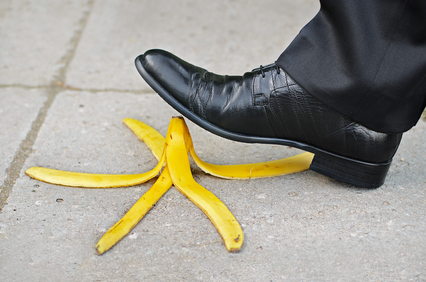
There are few people who have not viewed, and been amused by, the cartoon about the character who slips on a banana peel and ends up landing on his back in spectacular fashion. Despite the humor that can be found in these parodies, the slippery surface accidents that occur in real life often lead to serious injuries and debilitating pain.
In order to receive damages for a fall that was caused by a slippery surface, you have to prove that the owner of the property was negligent, not merely that the floor was slippery and that you fell and hurt yourself. The first thing that you will need to do is show what it was that made the surface slippery. Some of the common causes are:
- Water, snow, or ice on outside surfaces or entranceways;
- Oil, grease, or some other type of lubricant;
- A foreign object, such as the proverbial banana peel or other food debris;
- Spilled liquid; or
- Floor polish or wax.
Many of these things may be a temporary hazard. It is possible that the slippery surface was the result of something that happened right before you fell and the owner had no opportunity to learn about the problem and correct the situation. If a patron at a local food market drops a container of olives in oil on the floor, where it breaks open, and you slip in the mess thirty seconds after the incident, then it would be hard to prove that the market was negligent in your accident. However, if the spill remains on the floor for forty minutes before you fell and injured yourself, then you may be able to hold the market responsible for the harm that you suffered.
Another situation that may have led to your fall was when the owner took deliberate action, such as waxing the floor as part of routine maintenance, but did not take the appropriate precautions or plan carefully. When a floor is being waxed, there need to be warning signs and barriers, if practical. Although the presence of signs will not absolve an owner of negligence, they will weigh in his favor. However, another consideration is whether the danger could have been minimized with planning. If a property owner chooses to go ahead with waxing the floors in the middle of a workday when there is going to be heavy foot traffic through the area being waxed, then he is creating a situation where a jury may find that he acted in a negligent manner. If you add to this scenario the fact that it was a rainy or snowy day and the water that was brought in on wet shoes exacerbated an already dangerous situation, then the presence of warning signs may not be enough to prevent the owner from being liable for the damages that you sustained when you fell on these newly waxed floors.
A victim who has fallen on a slippery surface needs to prove that it was the negligence of the property owner that caused the harm. The knowledgeable and dedicated attorneys at Lundy Law understand how to evaluate an accident location, gather evidence, retain the proper experts, and present a solid case for why you deserve compensation for you medical bills, expenses, and pain and suffering relating to your accident. We are committed to fighting for your rights and offer a No Fee Assurance, where you do not pay anything until we win your case, to ensure that you have access to superior legal representation. We are ready to talk to you 24 hours a day, 7 days a week, so call us at 1-800-LundyLaw or complete our free online consultation form.















